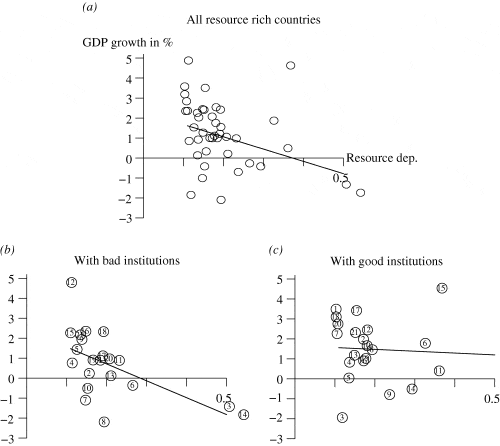The resource curse is the observation that countries endowed with a rich source of natural resources can struggle to make effective use of these and often end up with low levels of economic development than countries with low levels of natural resources.
There are various reasons put forward to explain this resource curse, such as corruption, appreciation in the exchange rate, foreign ownership and conflict. Examples of resource-rich countries, with relatively poor rates of economic growth, include Nigeria, Zambia, Sierra Leone, Angola, Saudi Arabia and Venezuela.
Resource-poor countries, such as Korea, Taiwan, Hong Kong, Japan and Singapore, by contrast, have experienced better rates of economic growth.
However, other economists are more sceptical and argue that natural resources can be consistent with improved living standards.
Reasons for resource curse
Civil war in control of ownership. Countries with a rich source of wealth, especially, diamonds, gold silver can be more vulnerable to civil conflict with competing interests fighting for control of the natural wealth. In countries, such as Congo, Angola and Sudan, the seeds of civil strife can be, at least, partly related to conflict over mineral resources. Civil war is the most striking reason for delaying and reversing economic development. Conflict leads to wasted resources, lost human capital and resources diverted away from productive investment.
However, the link between natural resources and civil conflict is not direct. Civil conflict is more closely associated with lack of stable government and tradition of political democracy. Many countries with rich sources of natural resources have not witnessed civil war.
Limits investment in diversified industries. A country with strong natural resources will invariably specialise in the production and export of this natural resource. Therefore, there is less incentive (or necessity) for the economy to diversify into different industries, such as the service sector and manufacturing. It can also inhibit the growth of human capital as the workforce is employed in low-skilled manual labour (mining) This is a problem because the economy becomes reliant on the price and demand of this commodity. If the resource runs out, the economy is left with only small industrial sector and scope for growth
Appreciation in the exchange rate. A country which finds natural resources will tend to have an appreciation of the exchange rate due to the resource effect. This has a benefit of making imports relatively cheaper (important if the country is net food importer). However, the appreciation of the exchange rate can damage other export industries and make them less competitive. This results in an unbalanced economy where only sectors which can thrive are the resources. This is also known as the “Dutch Disease”
For example, in the mini-oil boom of 1979-81 countries like Mexico, Venezuela and Nigeria saw rapid appreciation in the exchange rate due to the discovery of oil, but this meant virtually no other industries remained internationally competitive. A damaging effect in the long-term
Income elasticity of demand. Primary products tend to have a lower income elasticity of demand than services and manufactured goods. With rising global growth, there is a relatively smaller percentage increase in demand for primary products. This means countries producing primary products experience declining terms of trade.
Monopoly ownership. Natural resources tend to be owned by firms with significant degrees of monopoly and monopsony power. Often they are global multinationals, e.g. De Beers diamond mining, Oil production by Shell, BP and Esso. This means that the profits from selling natural resources are taken primarily by a small percentage of wealthy shareholders (often foreign). This means profits flow back to the country of the multinational and do not directly benefit the developing economy. Furthermore, the level of tax paid by multinationals is often set at low level to attract investment. Developing economies with weak legal structures and history of business also see profits syphoned off by corruption. Mining companies do provide employment, but the percentage of earnings going to workers is often low.
“Easy riches lead to sloth” A non-economic argument. But, the idea that countries who achieve ‘easy wealth’ have less incentive to work hard and develop a culture of entrepreneurship.
Evaluation of Resource Curse
Resource is not the issue but quality of institutions

This shows that countries with abundant resources have lower rates of economic growth.
However, if we look at countries with ‘good institutions’ then there appears to be no trade-off for the resource curse.
Resources are not necessarily an impediment to economic growth. Norway has made effective use of natural resources. Botswana is dependent on the diamond industry with 40% of GDP stemming from diamonds. But, between 1965 and 2002 had one of the world’s highest growth rates. Acemogluet al. (2002) attributed this performance to the good institutions of Botswana.
Empirical studies on the Resource Curse
Sachs and Warner found A negative correlation between resource abundance and rates of economic growth. They suggested rent-seeking activity from the abundance of raw materials can adversely affect political and economic structures.
Sachs, Jeffrey D. and Andrew M. Warner. “The Big Rush, Natural Resource Booms And Growth,” Journal of Development Economics, 1999, v59 (1, Jun), 43-76. Leading Issues in Economic Development, Oxford University Press, 2000.
Related
